Clinching of Carbon Fiber-Reinforced Composite and Aluminum Alloy
Abstract
:1. Introduction
2. Clinching
2.1. Fundamentals of Clinching
- -
- Securing the joining partners using a blank holder;
- -
- Partial penetration of the joining partners;
- -
- Partial displacement of the joining partners from the initial plane;
- -
- Subsequent upsetting;
- -
- Formation of an inseparable joint through spreading or extrusion.
2.2. Imperfection of Clinching CFRP and Aluminum
3. Advanced Clinching Methods
3.1. Modification of the Material Structure
3.2. Modification of the Material Property
3.3. Multi-Modification
3.3.1. Thermomechanical Mold Joining
3.3.2. Thermoclinching
3.3.3. Joining after Embedding of Inserts
3.3.4. Friction-Assisted Clinching
4. Inspiration for Further Process Evolution
5. Conclusions and Outlook
- Clinching with material removal offers enhanced material versatility. In designing a material removal process, prioritizing integration into conventional clinching processes is crucial.
- The process should be meticulously designed to minimize damage to the composite material during material removal and joining. Understanding the interaction between removal and forming processes serves as the foundation for devising a seamless, continuous process.
- Mechanical properties of clinched joints need not excessively emphasize tensile strength. Instead, optimal load capacity hinges on better accommodating adhesives. The use of adhesives should steer clear of excessive preload and temperature effects during the joining process.
Author Contributions
Funding
Conflicts of Interest
References
- Jacob, A. Carbon fibre and cars-2013 in review. Reinf. Plast. 2014, 58, 18–19. [Google Scholar] [CrossRef]
- Ouyang, Y.; Chen, C. Research advances in the mechanical joining process for fiber reinforced plastic composites. Compos. Struct. 2022, 296, 115906. [Google Scholar] [CrossRef]
- Song, C.Y.; Lei, L.; Yan, M. Clinched joining mechanical performance in multiple states. Int. J. Adv. Manuf. Technol. 2023, 129, 3799–3812. [Google Scholar] [CrossRef]
- Zhang, W.; Xu, J. Advanced lightweight materials for automobiles: A review. Mater. Des. 2022, 221, 110994. [Google Scholar] [CrossRef]
- Astarita, A. Joining of Composite Materials: An Introduction. Encycl. Mater. Compos. 2021, 3, 302. [Google Scholar]
- Harries, K.A.; Peck, A.J.; Abraham, E.J. Enhancing stability of structural steel sections using FRP. Thin-Walled Struct. 2009, 47, 1092–1101. [Google Scholar] [CrossRef]
- Hesse, H.; Lukaszewicz, H.J.A.; Duddeck, F. A method to reduce design complexity of automotive composite structures with respect to crashworthiness. Compos. Struct. 2015, 129, 236–249. [Google Scholar] [CrossRef]
- Wei, J.; Sun, L.; Lv, W.; Wang, J.; Wang, Z.; Duan, Y.; Li, L. Integrated design and experimental verification of assembly fiber reinforced thermoplastic plastics (AFRTP) automobile seat beams. Compos. Part B Eng. 2021, 220, 108968. [Google Scholar] [CrossRef]
- Yao, L.M.; Tan, S.Q.; Xu, Z.W. Towards carbon neutrality: What has been done and what needs to be done for carbon emission reduction. Environ. Sci. Pollut. Res. 2022, 30, 20570–20589. [Google Scholar] [CrossRef]
- Choi, J.Y.; Jeon, J.H.; Lyu, J.H.; Park, J.; Kim, G.Y.; Chey, S.Y.; Quan, Y.-J.; Bhandari, B.; Prusty, B.G.; Ahn, S.-H. Current Applications and Development of Composite Manufacturing Processes for Future Mobility. Int. J. Precis. Eng. Manuf. Technol. 2023, 10, 269–291. [Google Scholar] [CrossRef]
- Pejman, R.; Gorman, J.; Najaf, A.R. Multi-physics design of a new battery packaging for electric vehicles utilizing multifunctional composites. Compos. Part B Eng. 2022, 237, 109810. [Google Scholar] [CrossRef]
- Qbau, N.; Nam, N.D.; Hien, N.T.; Ca, N.X. Development of light weight high strength aluminum alloy for selective laser melting. J. Mater. Res. Technol. 2020, 9, 14075–14081. [Google Scholar] [CrossRef]
- Meng, F.; Li, W.; Fan, H.; Zhou, Y. A nonlinear theory for CFRP strengthened aluminum beam. Compos. Struct. 2015, 131, 574–577. [Google Scholar] [CrossRef]
- Liu, Q.; Shen, H.; Wu, Y.; Xia, Z.; Fang, J.; Li, Q. Crash responses under multiple impacts and residual properties of CFRP and aluminum tubes. Compos. Struct. 2018, 194, 87–103. [Google Scholar] [CrossRef]
- Afseth, A. Aluminum Battery Enclosure Design, Constellium. Available online: https://www.cargroup.org/wp-content/uploads/2021/02/Aluminum-Battery-Enclosures-Constellium-February-2021-FINAL.pdf (accessed on 1 May 2024).
- Constellium Develops New Alloys for EV Battery Enclosures, SAE International. 19 February 2021. Available online: https://www.sae.org/news/2021/02/constellium-aluminum-ev-battery-enclosures (accessed on 1 May 2024).
- Gude, M.; Stegelmann, M.; Müller, M.; Demnitz, K. Studie zum ressourceneffizienten Leichtbau. Light. Des. 2018, 11, 30–35. [Google Scholar] [CrossRef]
- DIN 8593-5; Fertigungsverfahren Fuegen-Teil 5: Fuegen Durch Umformen; Einordnung, Unterteilung, Begriffe. Beuth Verlag GmbH: Berlin, Germany, 2003.
- Hahn, O.; Klemens, U. Fügen Durch Umformen: Nieten und Durchsetzfügen; Innovative Verbindungsverfahren für Die Praxis; Verlag und Vertriebsges: Heidelberg, Germany, 1996. [Google Scholar]
- Meschut, G.; Janzen, V.; Olfermann, T. Innovative and Highly Productive Joining Technologies for Multi-Material Lightweight Car Body Structures. J. Mater. Eng. Perform. 2014, 23, 1515–1523. [Google Scholar] [CrossRef]
- Meng, Y.C.; Cao, B.Q.; Qiu, Y.; Chen, H.; Xie, Y.; Wan, L.; Huang, Y. Equal-load-bearing joining of alclad AA2024-T4 alloy stringers and skins in aviation via friction stir lap welding. J. Manuf. Process. 2021, 68, 1295–1302. [Google Scholar] [CrossRef]
- Meschut, G.; Merklein, M.; Brosius, A.; Drummer, D.; Fratini, L.; Füssel, U.; Gude, M.; Homberg, W.; Martins, P.; Bobbert, M.; et al. Review on mechanical joining by plastic deformation. J. Adv. Join. Process. 2022, 5, 100113. [Google Scholar] [CrossRef]
- DIN 2304-1: 2016; Adhesive Bonding Technology-Quality Requirements for Bonding Processes-Part: 1: Bonding Process Chain. Beuth Verlag: Berlin, Germany, 2016.
- Ouyang, X.; Chen, C. Research on the joining of aluminum alloy and high-strength steel by dieless clinched-adhesive processes. J. Mater. Res. Technol. 2023, 24, 5526–5540. [Google Scholar] [CrossRef]
- Gleich, H.; Hartwig, A.; Lohse, H. Why pretreatment is so important. In Adhesion: Adhesives and Sealants; Springer Vieweg: Wiesbaden, Germany, 2016. [Google Scholar]
- Li, Y.B.; Ma, Y.W.; Lou, M.; Zhang, G.; Zhang, Q.; Qi, L.; Deng, L. Advances in Spot Joining Technologies of Light-weight Thin-walled Structures. J. Mech. Eng. 2020, 56, 125–146. [Google Scholar]
- Wippo, V.; Winter, Y.; Jaeschke, P.; Suttmann, O.; Kaierle, S.; Overmeyer, L. Temperature distribution during laser based heat conduction welding of CFRP. Procedia CIRP 2018, 74, 553–556. [Google Scholar] [CrossRef]
- Biswal, A.K.; Nandi, A.; Wang, H.; Vashisth, A. Ultrasonic welding of fiber reinforced vitrimer composites. Compos. Sci. Technol. 2023, 242, 110202. [Google Scholar] [CrossRef]
- Hicks, J. Welded Joint Design, 3rd ed.; Woodhead Publishing: Sawston, UK, 1990. [Google Scholar]
- Kah, P.; Suoranta, R.; Martikainen, J. Joining of Sheet Metals Using Different Welding Processes. In Proceedings of the 16th International Conference, Mechanika, Lithuania, 7–8 April 2011. [Google Scholar]
- Wang, R.; Jiang, D.X.; Zhang, Q.X.; Wang, H.; Zhang, J.; Sun, Y. Effect of Arc Welding Repair on Sealing Performance of resistance Weld-Bonded Structure. Mach. Des. Res. 2021, 37, 96–100. [Google Scholar]
- Huang, S.; Xu, L.; Lou, M.; Chen, H.; Zhang, K.; Li, Y. Keyhole-induced pore formation mechanism in la-ser-MIG hybrid welding of aluminum alloy based on experiment and multiphase numerical model. J. Mater. Process. Technol. 2023, 314, 117903. [Google Scholar] [CrossRef]
- Ambrosio, D.; Sharma, A.; Mukuda, M.; Morisada, Y.; Fujii, H. Feasibility of friction stir welding using a hemispherical tool tilted towards the retreating side. J. Adv. Join. Process. 2024, 9, 100180. [Google Scholar] [CrossRef]
- Günter, H.; Meschut, G. Joining of ultra-high-strength steels using resistance element welding on conventional resistance spot welding guns. Weld. World 2021, 65, 1899–1914. [Google Scholar] [CrossRef]
- Bu, H.; Gao, Q.; Li, Y.; Wang, F.; Zhan, X. Comparative Study on Microstructure and Aluminum Distribution Between Laser Beam Welding and Electron Beam Welding of Ti–6Al–4V Alloy Plates. Met. Mater. Int. 2021, 27, 3449–3461. [Google Scholar] [CrossRef]
- Singh, R. Applied Welding Engineering, 3rd ed.; Butterworth-Heinemann: Oxford, UK, 2020. [Google Scholar]
- Qin, Y.; Jiao, Z.; Feng, Z.; Shi, N.; Han, J.; Wei, X. Influence of Welding Sequence on Welding Deformation of T-Joint. In Transactions on Intelligent Welding Manufacturing; Springer: Singapore, 2020. [Google Scholar]
- Go, B.S.; Oh, K.H.; Kwon, S.I.; Bang, H.-S. Reduction Characteristics of Welding Deformation According to Cooling Distance in Heat Sink Welding. Int. J. Precis. Eng. Manuf. 2022, 23, 1229–1236. [Google Scholar] [CrossRef]
- Nourani, S.A.; Pons, D.J.; Tamadon, A.; Symons, D. Microstructural deformation in the clinching process. J. Adv. Join. Process. 2021, 3, 100041. [Google Scholar] [CrossRef]
- Meschut, G.; Janzen, V.; Matzke, M.; Olfermann, T. Comparison of Innovative Thermal Joining Technologies for Joining Ultra-High-Strength Steels in Multi-Material Structures, DVS-Berichte, Band 296; DVS Media GmbH: Berlin, Germany, 2013. [Google Scholar]
- Ma, Y.; Akita, R.; Abe, Y.; Geng, P.; Luo, P.; Tsutsumi, S.; Ma, N. Mechanical Performance Evaluation of Multi-Point Clinch–Adhesive Joints of Aluminum Alloy A5052-H34 and High-Strength Steel JSC780. Automot. Innov. 2023, 6, 340–351. [Google Scholar] [CrossRef]
- Lee, H.S. 10-Diffusion bonding of metal alloys in aerospace and other applications. In Welding and Joining of Aerospace Materials; Woodhead Publishing: Sawston, UK, 2021; pp. 305–327. [Google Scholar]
- Ying, L.; Dong, Q.; Gao, T.; Dai, M.; Hu, P. Self-piercing riveting of dissimilar carbon fiber-reinforced composites and aluminum alloy sheets: State-of-the-art achievements. Int. J. Adv. Manuf. Technol. 2023, 130, 1–22. [Google Scholar] [CrossRef]
- Pramanik, A.; Basak, A.K.; Dong, Y.; Sarker, P.K.; Uddin, M.S.; Littlefair, G.; Dixit, A.R.; Chattopadhyaya, S. Joining of carbon fibre reinforced polymer (CFRP) composites and aluminium alloys—A review. Compos. Part A Appl. Sci. Manuf. 2017, 101, 1–29. [Google Scholar] [CrossRef]
- Troschitz, J.; Gröger, B.; Würfel, V.; Kupfer, R.; Gude, M. Joining Processes for Fibre-Reinforced Thermoplastics: Phenomena and Characterisation. Materials 2022, 15, 5454. [Google Scholar] [CrossRef] [PubMed]
- Szlosarek, R.; Karall, T.; Enzinger, N.; Hahne, C.; Meyer, N. Mechanical testing of flow drill screw joints between fibre-reinforced plastics and metals. Mater. Test. 2013, 55, 737–742. [Google Scholar] [CrossRef]
- Podlesak, F.; Halsig, A.; Hofer, K.; Kaboli, R.; Mayr, P. Spin blind-riveting: Secure joining of plastic with metal. Weld. World 2015, 59, 927–932. [Google Scholar] [CrossRef]
- Min, J.; Li, Y.; Li, J.; Carlson, B.E.; Lin, J. Friction stir blind riveting of carbon fiber-reinforced poly-mer composite and aluminum alloy sheets. Int. J. Adv. Manuf. Technol. 2015, 76, 1403–1410. [Google Scholar] [CrossRef]
- DVS/EFB 3420; Clinching-Basics. Verlag für Schweissen und Verwandte Verfahren: Düsseldorf, Germany, 2021.
- Groche, P.; Wohletz, S.; Brenneis, M.; Pabst, C.; Resch, F. Joining by forming—A review on joint mechanisms, applications and future trends. J. Mater. Process. Technol. 2014, 214, 1972–1994. [Google Scholar] [CrossRef]
- Qin, D.; Chen, C.; Li, H.; Ren, X. Investigation of the novel two-step flat clinching process to achieve double-sided flat surfaces on engineering structures. J. Braz. Soc. Mech. Sci. Eng. 2022, 44, 525. [Google Scholar] [CrossRef]
- Peng, H.; Chen, C.; Zhang, H.; Ran, X. Recent development of improved clinching process. Int. J. Adv. Manuf. Technol. 2020, 110, 3169–3199. [Google Scholar] [CrossRef]
- Kupfer, R.; Köhler, D.; Römisch, D.; Wituschek, S.; Ewenz, L.; Kalich, J.; Weiß, D.; Sadeghian, B.; Busch, M.; Krüger, J.; et al. Clinching of Aluminum Materials–Methods for the Continuous Characterization of Process, Microstructure and Properties. J. Adv. Join. Process. 2022, 5, 100108. [Google Scholar] [CrossRef]
- Schürmann, H. Konstruieren mit Faser-Kunststoff-Verbunden; Springer: Heidelberg, Germany, 2007; 13. [Google Scholar]
- Behrens, B.A.; Rolfes, R.; Vucetic, M.; Reinoso, J.; Vogler, M.; Grbic, N. Material Modelling of Short Fiber Rein-forced Thermoplastic for the FEA of a Clinching Test. Procedia CIRP 2014, 18, 250–255. [Google Scholar] [CrossRef]
- Ning, H.B.; Lu, N.; Hassen, A.A.; Chawla, K.; Selim, M.; Pillay, S. A review of Long fibre thermoplastic (LFT) composites. Int. Mater. Rev. 2020, 65, 164–188. [Google Scholar] [CrossRef]
- Petrů, M.; Novák, O. FEM Analysis of Mechanical and Structural Properties of Long Fiber-Reinforced Composites, Finite Element Method–Simulation, Numerical Analysis and Solution Techniques; IntechOpen: London, UK, 2018. [Google Scholar]
- Lambiase, F.; Ko, D.C. Feasibility of mechanical clinching for joining aluminum AA6082-T6 and Carbon Fiber Reinforced Polymer sheets. Mater. Des. 2016, 107, 341–352. [Google Scholar] [CrossRef]
- Lambiase, F.; Durante, M.; DiIlio, A. Fast joining of aluminum sheets with Glass Fiber Reinforced Polymer (GFRP) by mechanical clinching. J. Mater. Process. Technol. 2016, 236, 241–251. [Google Scholar] [CrossRef]
- Han, D.; Yang, K.; Meschut, G. Mechanical joining of glass fibre reinforced polymer (GFRP) through an innovative solid self-piercing rivet. J. Mater. Process. Technol. 2021, 296, 117182. [Google Scholar] [CrossRef]
- Lee, C.J.; Lee, S.H.; Lee, J.M.; Kim, B.H.; Kim, B.M.; Ko, D.C. Design of Hole-Clinching Process for Joining CFRP and Aluminum Alloy Sheet. Int. J. Precis. Eng. Manuf. 2014, 15, 1151–1157. [Google Scholar] [CrossRef]
- Hörhold, R.; Müller, M.; Merklein, M.; Meschut, G. Mechanical properties of an innovative shear-clinching technology for ultra-high-strength steel and aluminium in light-weight car body structures. Weld. World 2016, 60, 613–620. [Google Scholar] [CrossRef]
- Lee, S.H.; Lee, C.J.; Lee, K.H.; Lee, J.M.; Kim, B.M.; Ko, D.C. Influence of tool shape on hole clinching for car-bon fiber-reinforced plastic and SPRC440. Adv. Mech. Eng. 2015, 6, 810864. [Google Scholar] [CrossRef]
- Liu, Y.; Zhuang, W.M.; Wu, S.J. Damage to carbon fibre reinforced polymers (CFRP) in hole-clinched joints with aluminium alloy and CFRP. Compos. Struct. 2020, 234, 111710. [Google Scholar] [CrossRef]
- Han, W.Q.; Hu, K.J.; Shi, Q.H.; Zhu, F. Damage evolution analysis of open-hole tensile laminated composites using a progress damage model verified by AE and DIC. Compos. Struct. 2020, 247, 112452. [Google Scholar] [CrossRef]
- Busse, S.; Merklein, M.; Roll, K.; Ruther, M.; Zürn, M. Development of a mechanical joining process for automotive body-in-white production. Int. J. Mater. Form. 2010, 3, 1059–1062. [Google Scholar] [CrossRef]
- Chen, C.; Zhao, S.D.; Han, X.L.; Cui, M.; Fan, S. Investigation of mechanical behavior of the re-shaped joints realized with different reshaping forces. Thin-Walled Struct. 2016, 107, 266–273. [Google Scholar] [CrossRef]
- Lee, C.J.; Kim, B.M.; Kang, B.S.; Song, W.-J.; Ko, D.-C. Improvement of joinability in a hole clinching process with aluminum alloy and carbon fiber reinforced plastic using a spring die. Compos. Struct. 2017, 173, 58–69. [Google Scholar] [CrossRef]
- Lee, C.J.; Lee, J.M.; Ryu, H.Y.; Lee, K.H.; Kim, B.M.; Ko, D.C. Design of hole-clinching process for joining of dis-similar materials–Al6061-T4 alloy with DP780 steel, hot pressed 22MnB5 steel, and carbon fiber reinforced plastic. J. Mater. Process. Technol. 2014, 214, 2169–2178. [Google Scholar] [CrossRef]
- Latorre, N.; Casellas, D.; Costa, J. A punching process to join metal sheets and fibre reinforced polymer composites by mechanical interlocking. Compos. Part A Appl. Sci. Manuf. 2023, 175, 107744. [Google Scholar] [CrossRef]
- Lin, P.C.; Lin, J.W.; Li, G.X. Clinching process for aluminum alloy and carbon fiber-reinforced thermoplastic sheets. Int. J. Adv. Manuf. Technol. 2018, 97, 529–541. [Google Scholar] [CrossRef]
- Vorderbrüggen, J.; Gröger, B.; Kupfer, R.; Hoog, A.; Gude, M.; Meschut, G. Phenomena of forming and failure in joining hybrid structures-Experimental and numerical studies of clinching thermo-plastic composites and metal. AIP Conf. Proc. 2019, 2113, 050016. [Google Scholar]
- Schramm, B.; Friedlein, J.; Gröger, B.; Bielak, C.; Bobbert, M.; Gude, M.; Meschut, G.; Wallmersperger, T.; Mergheim, J. A Review on the Modeling of the Clinching Process Chain—Part II: Joining Process. J. Adv. Join. Process. 2022, 6, 100134. [Google Scholar] [CrossRef]
- Meschut, G.; Vorderbrüggen, J.; Gude, M.; Kupfer, R.; Gröger, B. Entwicklung eines Clinchverfahrens für Thermoplastische FKV in Mischbauweise; EFB-Forschungsbericht Nr. 524: Hannover, Germany, 2019; p. 29. [Google Scholar]
- Yarcu, S.; Behrens, B.A.; Huebner, S.; Schuchardt, T.; Dilger, K.; Meichsner, T.P. Clinching of inductively heated aluminum die casting. Prod. Eng. 2022, 16, 223–233. [Google Scholar] [CrossRef]
- Gemeinsame Forschung in der Mechanischen Fügetechnik 2023. EFB Europäische Forschungsgesellschaft für Blechverarbeitung e.V.–FOSTA Forschungsvereinigung Stahlanwendung e.V. Tagungsband T 54. 2023. Available online: https://www.fuegetechnik.org/fk-programm.html (accessed on 1 May 2024).
- Lin, P.C.; Lo, S.M. Friction stir clinching of alclad AA2024-T3 sheets. Int. J. Adv. Manuf. Technol. 2017, 92, 2425–2437. [Google Scholar] [CrossRef]
- Tatsuno, D.; Yineyama, T.; Kawamoto, K.; Okamoto, M. Hot press forming of thermoplastic CFRP sheets. Procedia Manuf. 2018, 15, 1730–1737. [Google Scholar] [CrossRef]
- Härtel, S.; Graf, M.; Gerstmann, T.; Awiszus, B. Heat Generation During Mechanical Joining Processes–by the Example of Flat-Clinching. Procedia Eng. 2017, 184, 251–265. [Google Scholar] [CrossRef]
- Seidlitz, H.; Czech, A.; Ulke-Winter, L.; Kroll, L. Thermomechanisches Ausform-fügen für thermoplastische FVK. Lightweight Des. 2011, 3, 16–23. [Google Scholar] [CrossRef]
- Seidlitz, H.; Ulke-Winter, L.; Kroll, L. New Joining Technology for Optimized Met-al/Composite Assemblies. J. Eng. 2014, 2014, 958501. [Google Scholar]
- Gude, M.; Hufenbach, W.; Vogel, C.; Freund, A.; Kupfer, R. Thermoclinching—A novel joining process for lightweight structures in multimaterial design. Compos. Theory Pract. 2014, 14, 128–133. [Google Scholar]
- Gude, M.; Hufenbach, W.; Kupfer, R.; Freund, A.; Vogel, C. Development of novel form-locked joints for textile reinforced thermoplastices and metallic components. J. Mater. Process. Technol. 2015, 216, 140–145. [Google Scholar] [CrossRef]
- Gude, M.; Freund, A.; Vogel, C. Numerical Simulation Based Process Development of the Novel Thermoclinching Technology for Textile Reinforced Thermoplastics. In Proceedings of the 20th international Conference on Composite Materials, Copenhagen, Danmark, 19–24 July 2015. [Google Scholar]
- Hufenbach, W.; Adam, F.; Kupfer, R. A novel textile-adapted notching technology for bolted joints in textile-reinforced thermoplastic composites. ECCM 2010, 461, 1–9. [Google Scholar]
- Troschitz, J.; Kupfer, R.; Gude, M. Process-integrated embedding of metal inserts in continuous fibre reinforced thermoplastics. Procedia CIRP 2019, 85, 84–89. [Google Scholar] [CrossRef]
- Troschitz, J.; Vorderbrüggen, J.; Gude, M.; Meschut, G. Clinching and resistance spot welding of thermoplastic composites with metals using inserts as joining interfaces. In Proceedings of the Twenty-Third International Conference on Composite Materials (ICCM23), Belfast, UK, 30 July–4 August 2023. [Google Scholar]
- Ma, Y.; Yu, Y.; Geng, P.; Ihara, R.; Maeda, K.; Suzuki, R.; Suga, T.; Ma, N. Fracture modeling of resistance spot welded ultra−high−strength steel considering the effect of liquid metal embrittlement crack. Mater. Des. 2021, 210, 110075. [Google Scholar] [CrossRef]
- Lambiase, F.; Paoletti, A.; DiIlio, A. Advances in Mechanical Clinching: Employment of a rotating tool. Procedia Eng. 2017, 183, 200–205. [Google Scholar] [CrossRef]
- Chen, C.; Zhao, S.; Cui, M.; Han, X.; Fan, S.; Ishida, T. An experimental study on the compressing process for joining Al6061 sheets. Thin-Walled Struct. 2016, 108, 56–63. [Google Scholar] [CrossRef]
- Müller, M.; Hörhold, R.; Merklein, M.; Meschut, G. Analysis of Material Behaviour in Experimental and Simulative Setup of Joining by Forming of Aluminium Alloy and High Strength Steel with Shear-Clinching Technology. Adv. Mater. Res. 2014, 966–967, 549–556. [Google Scholar] [CrossRef]
- Lambiase, F.; Paoletti, A. Friction-assisted clinching of Aluminum and CFRP sheets. J. Manuf. Process. 2018, 31, 12–22. [Google Scholar] [CrossRef]
- Latorre, N.; Casellas, D.; Costa, J.; Garcia-Llamas, E.; Pujante, J. Forming of mechanically interlocked aluminium and carbon fibre reinforced polymer parts with complex geometry. Mater. Res. Proc. 2024, 41, 1640–1649. [Google Scholar]
- Han, D.; Hörhold, R.; Müller, M.; Wiesenmayer, S.; Merklein, M.; Meschut, G. Shear-Clinching of Multi-Element Specimens of Aluminium Alloy and Ultra-High-Strength Steel. Key Eng. Mater. 2018, 767, 389–396. [Google Scholar] [CrossRef]

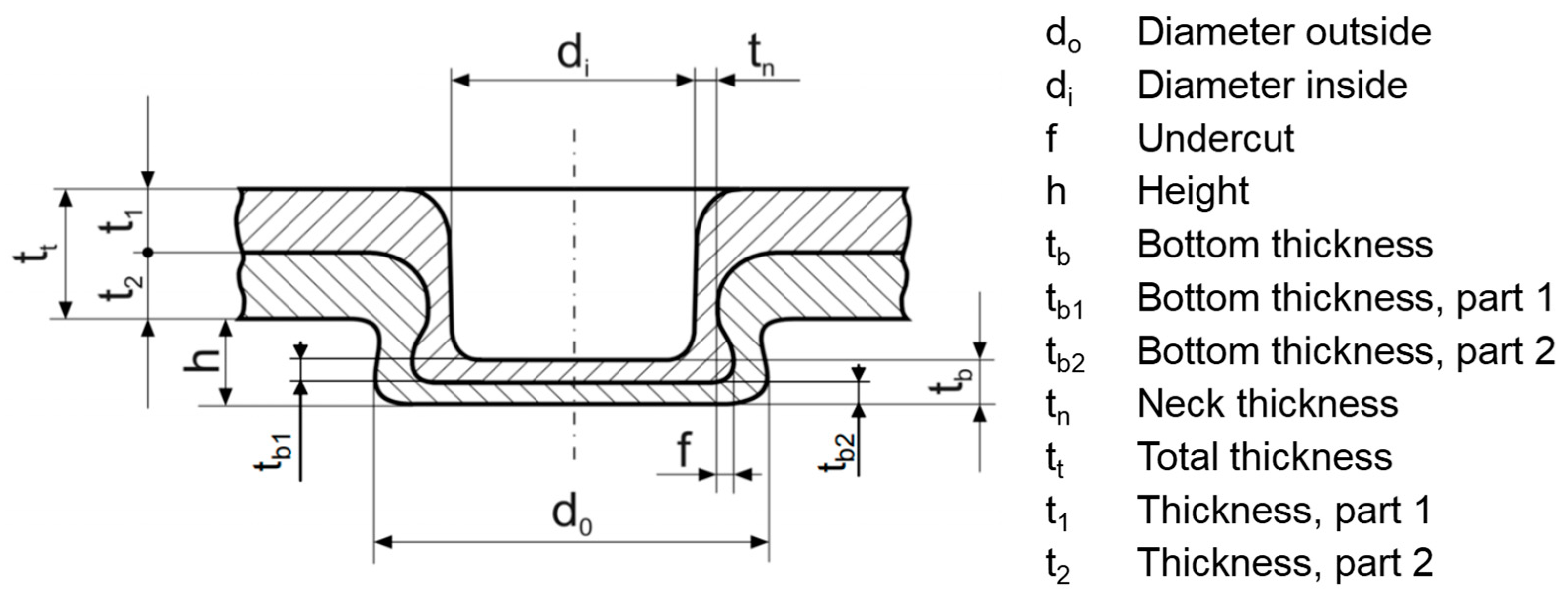
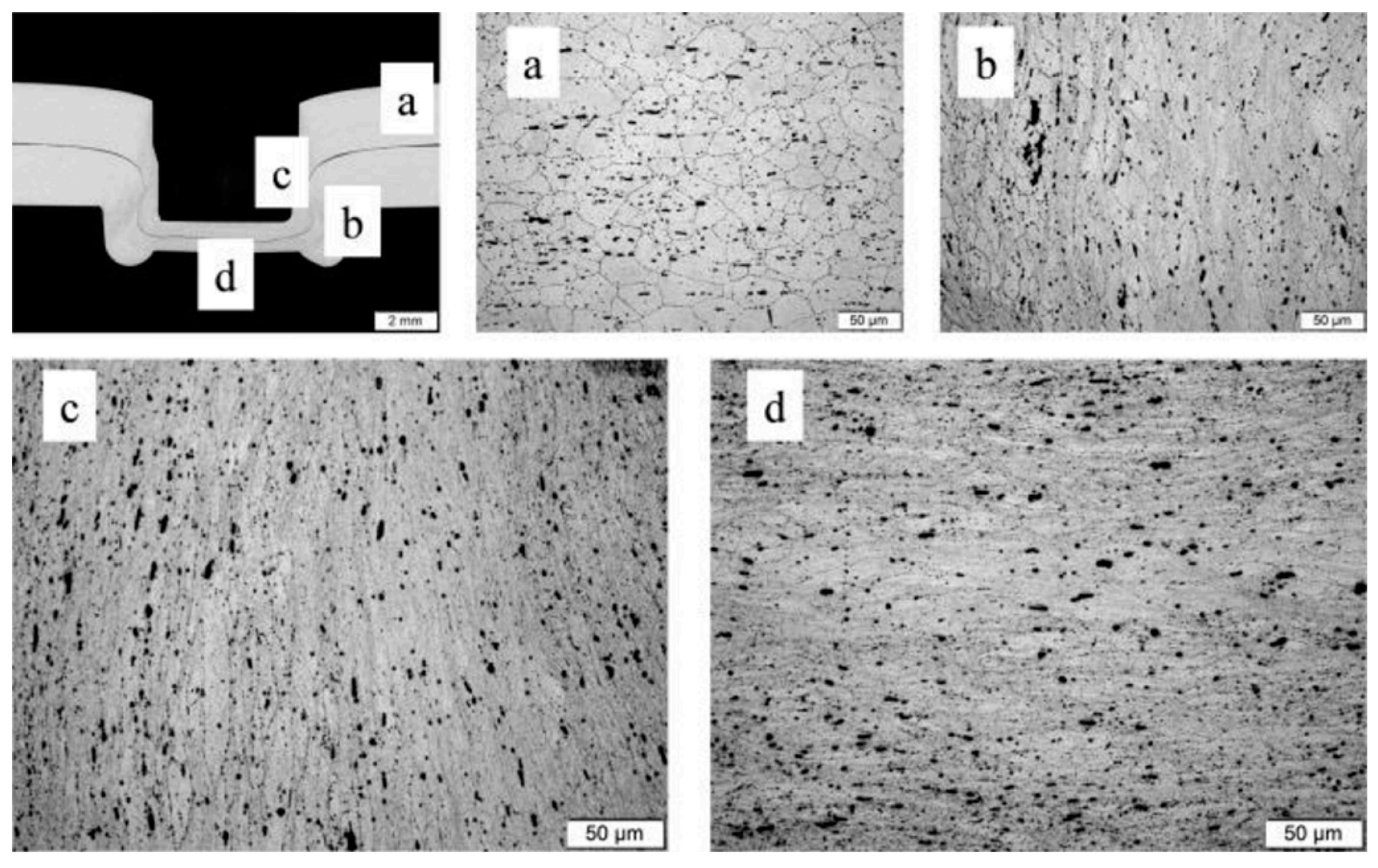
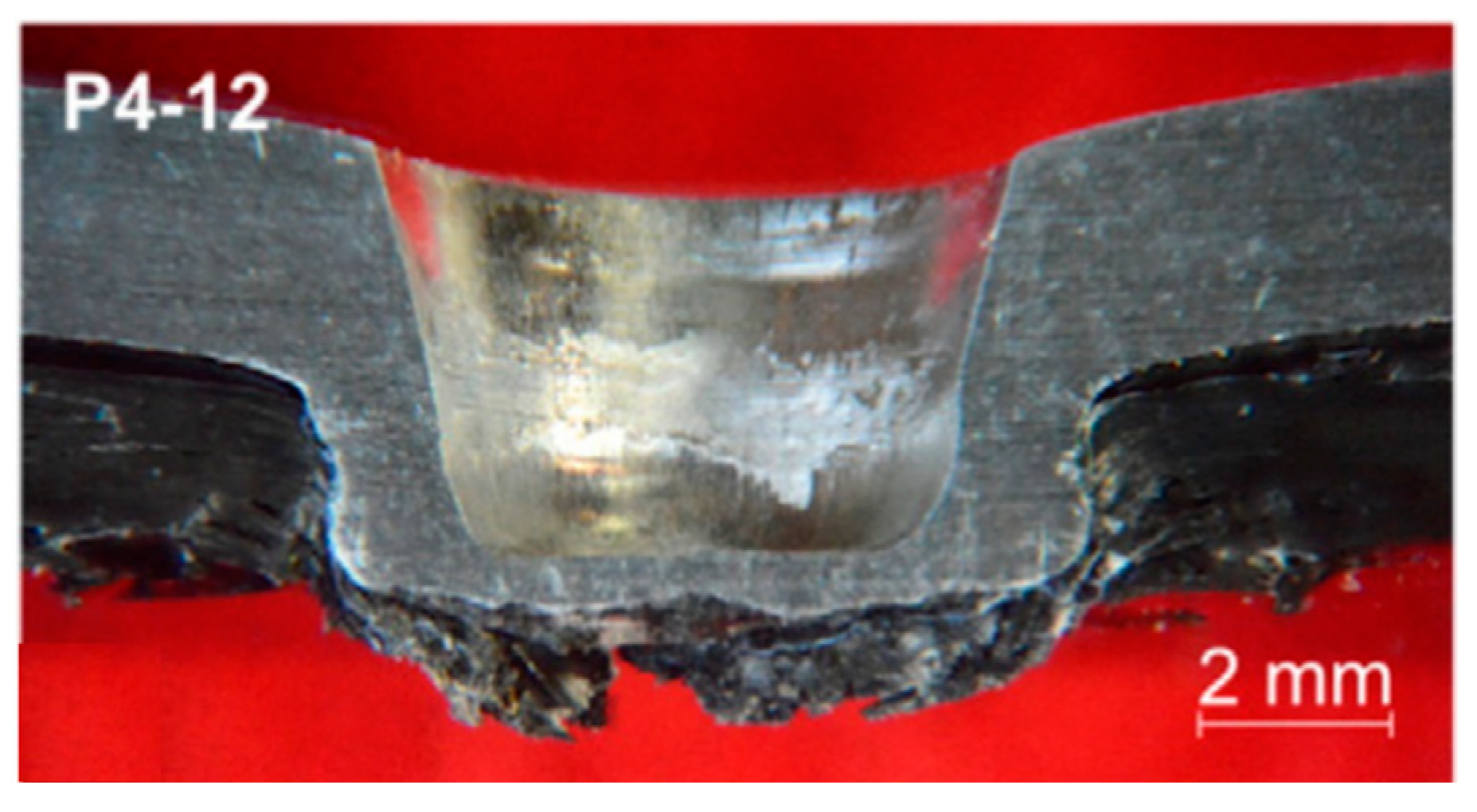
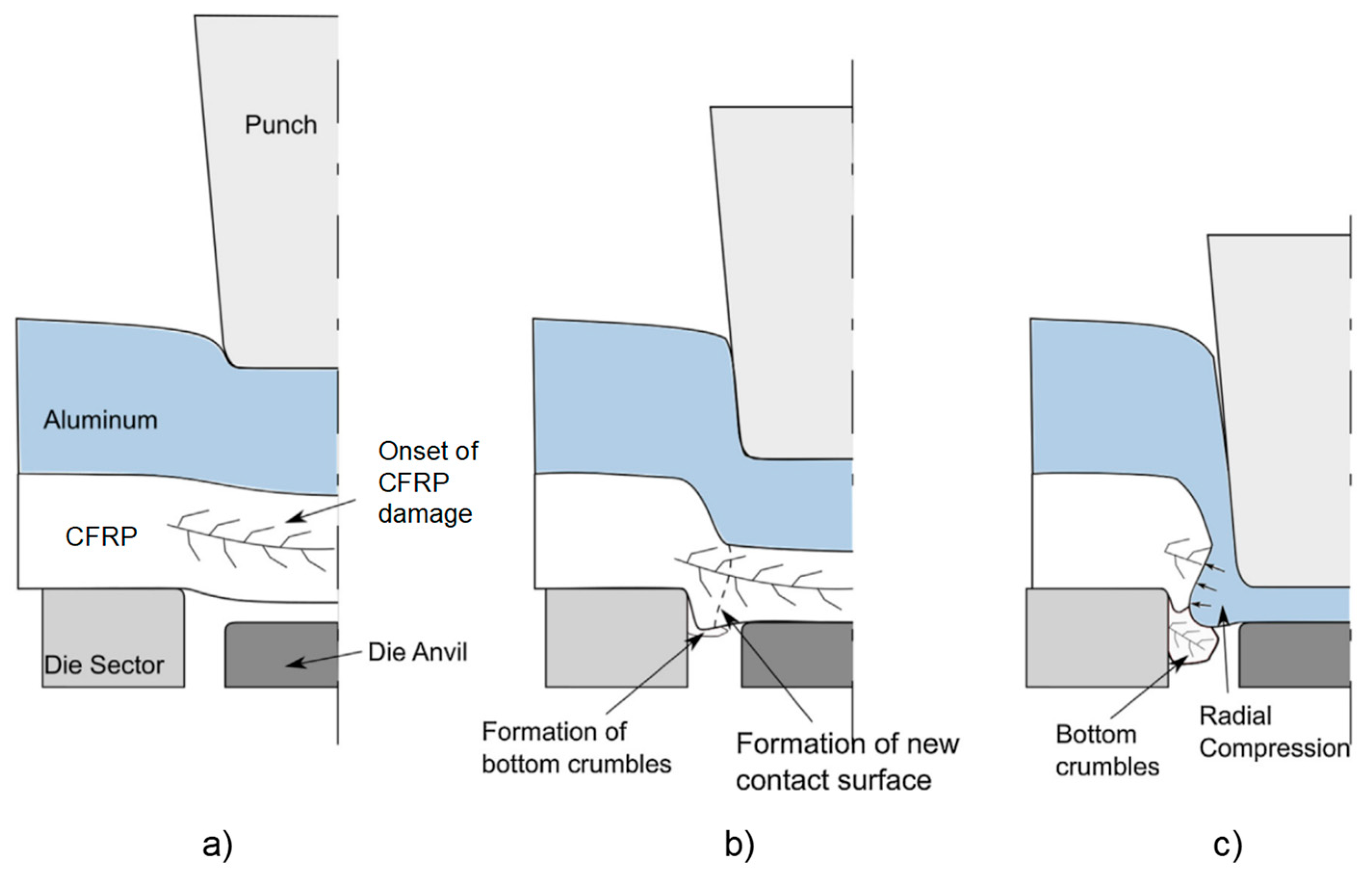



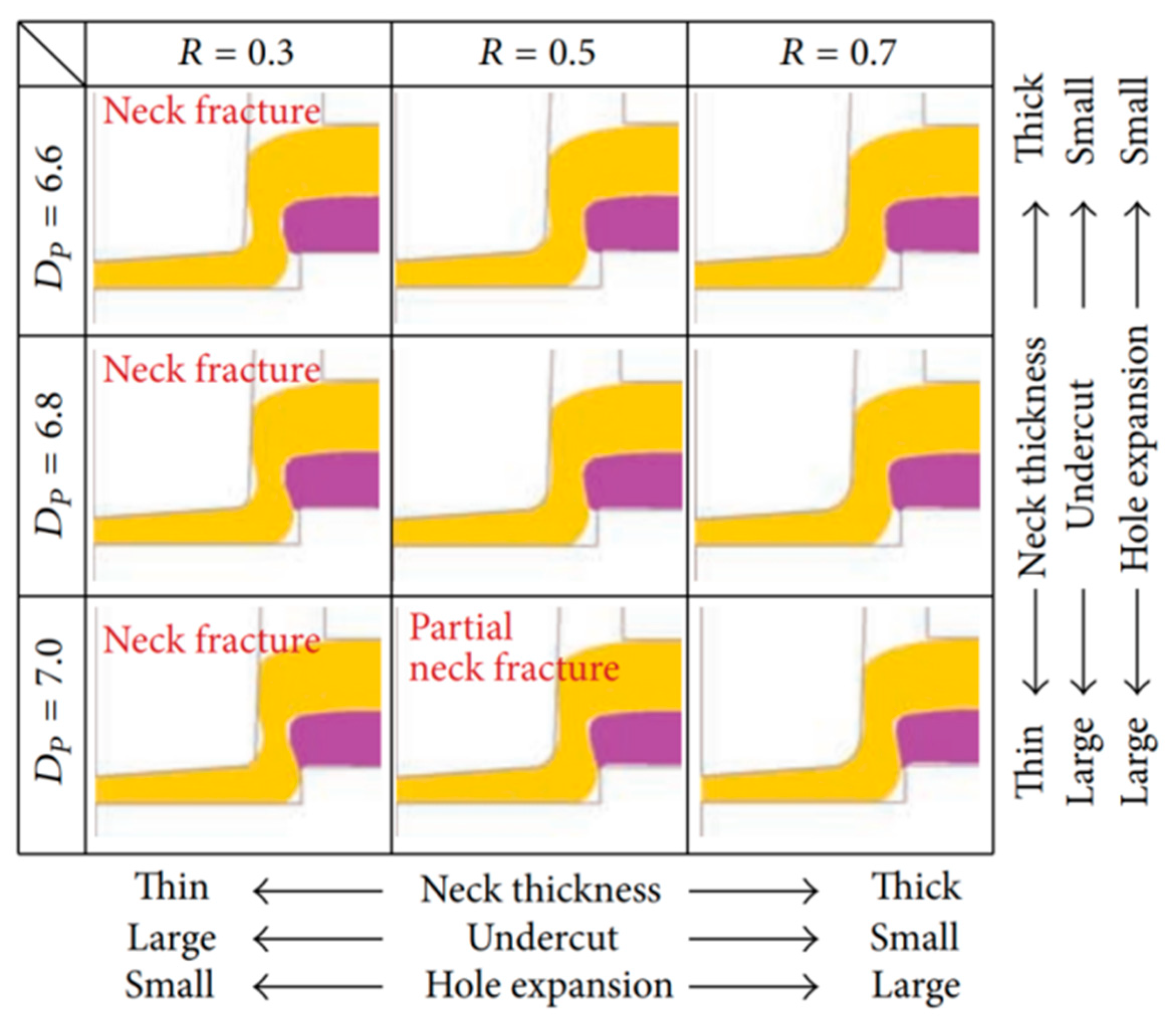


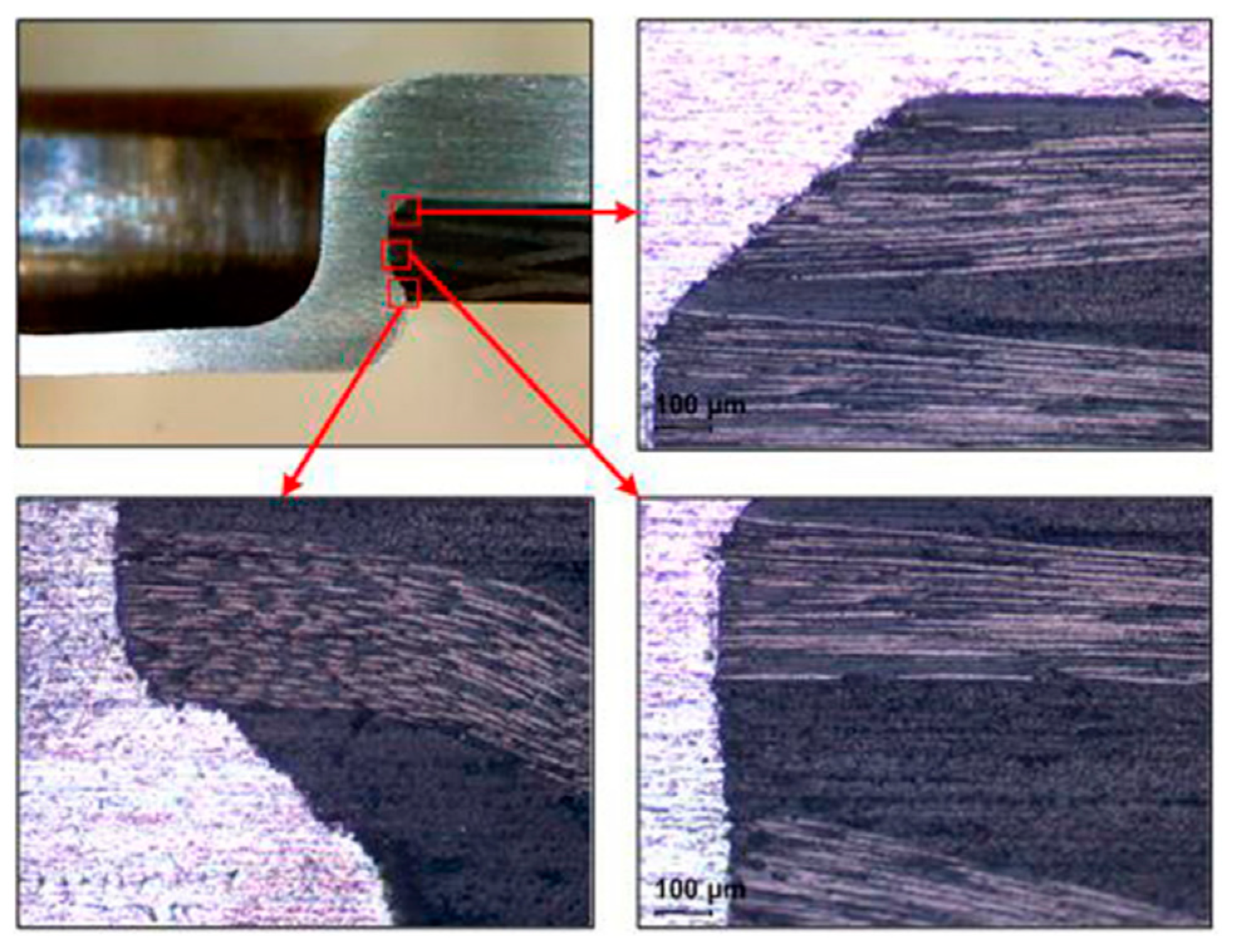
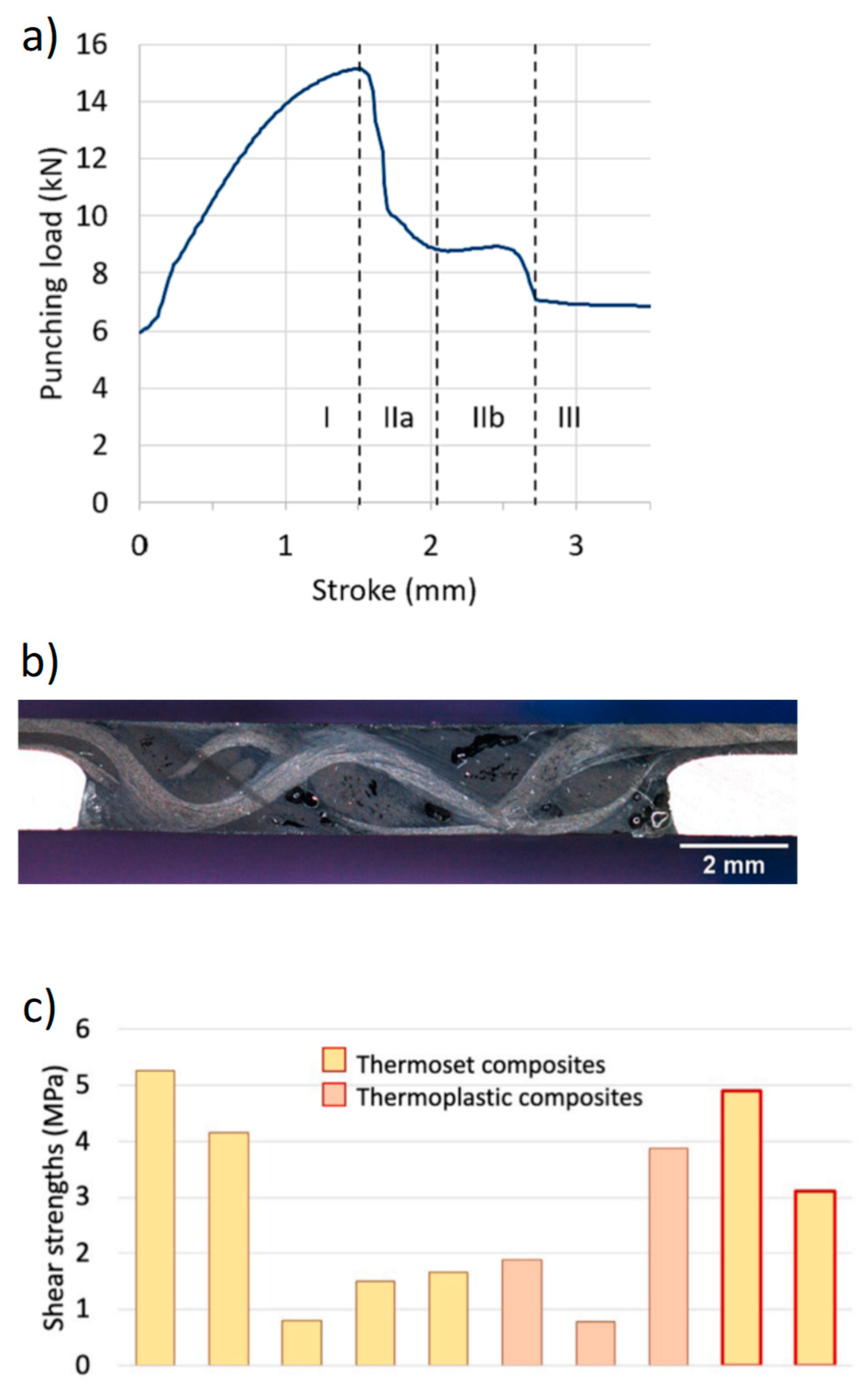
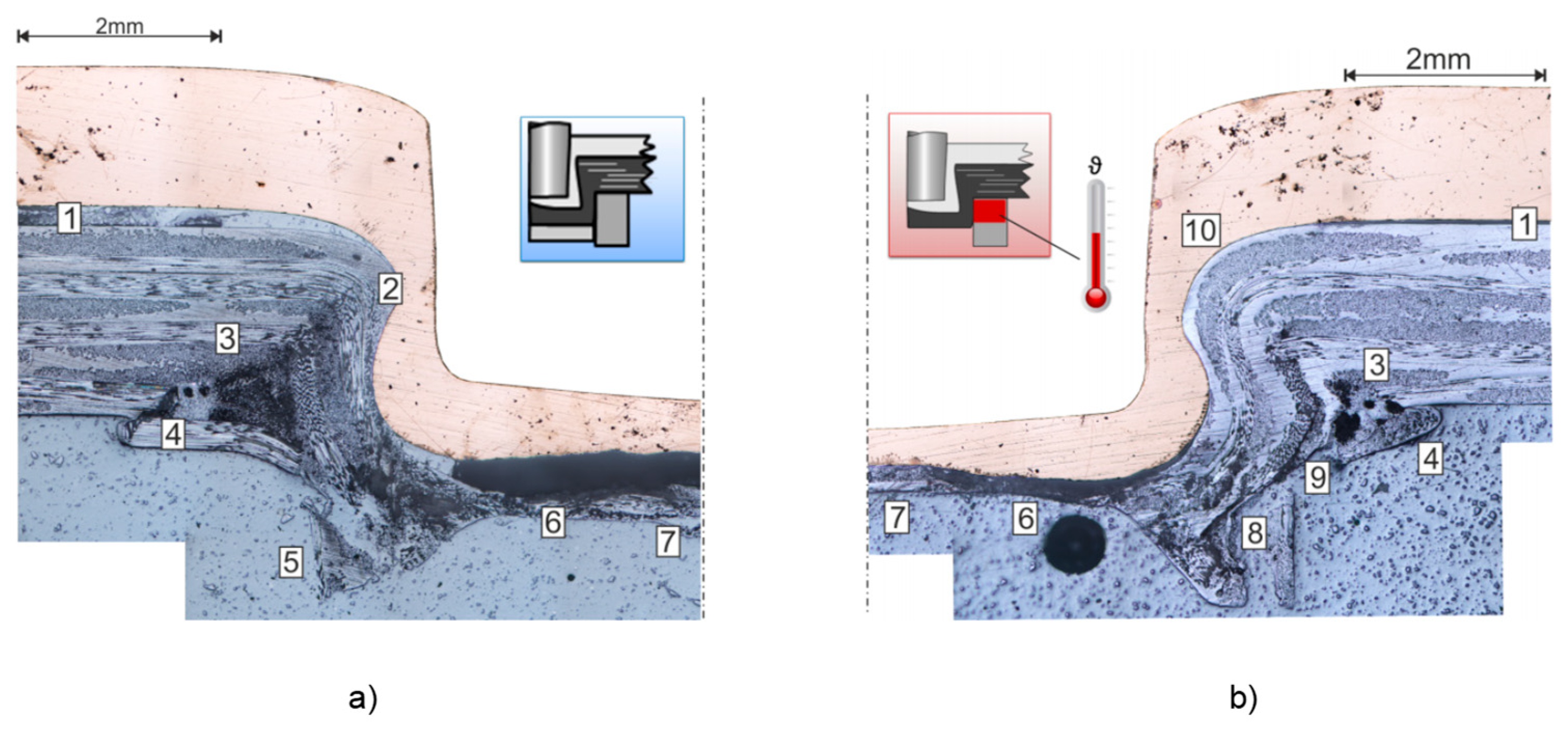

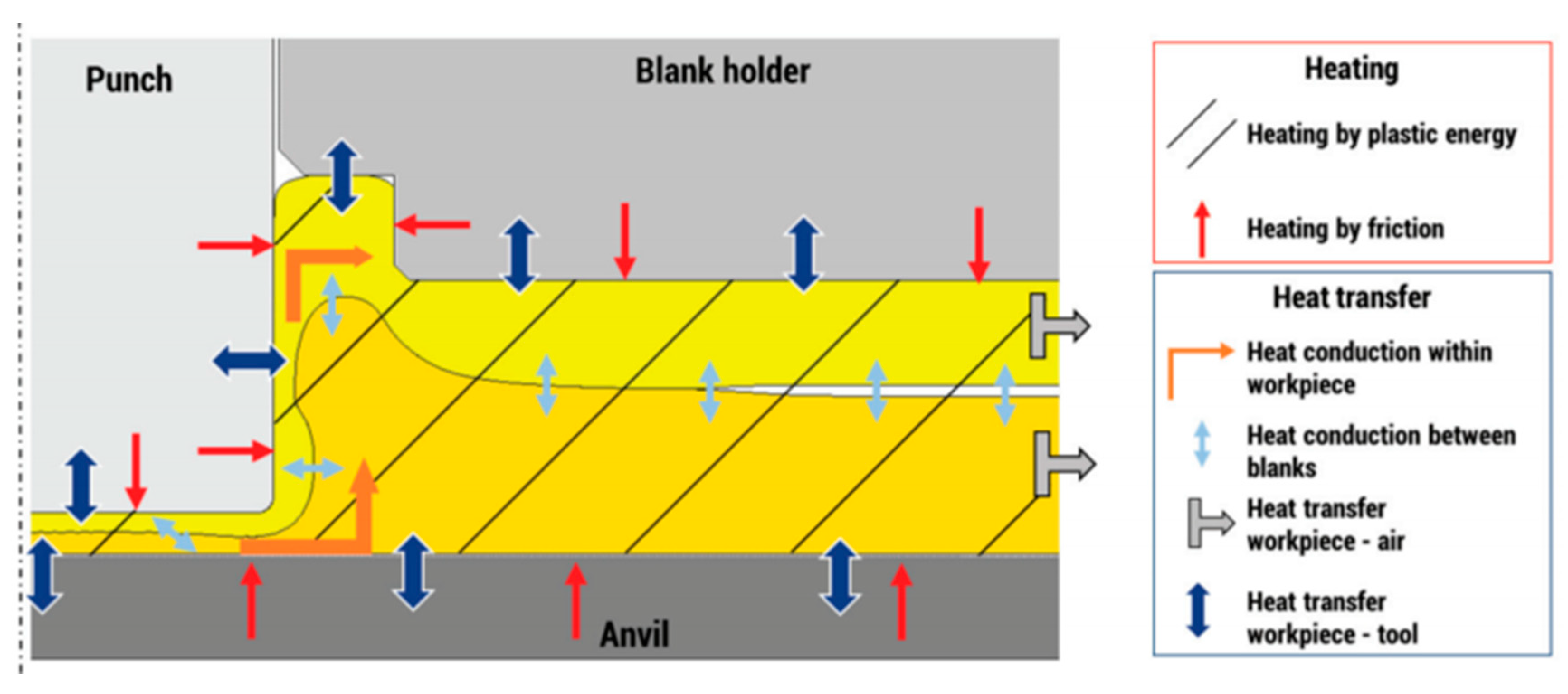

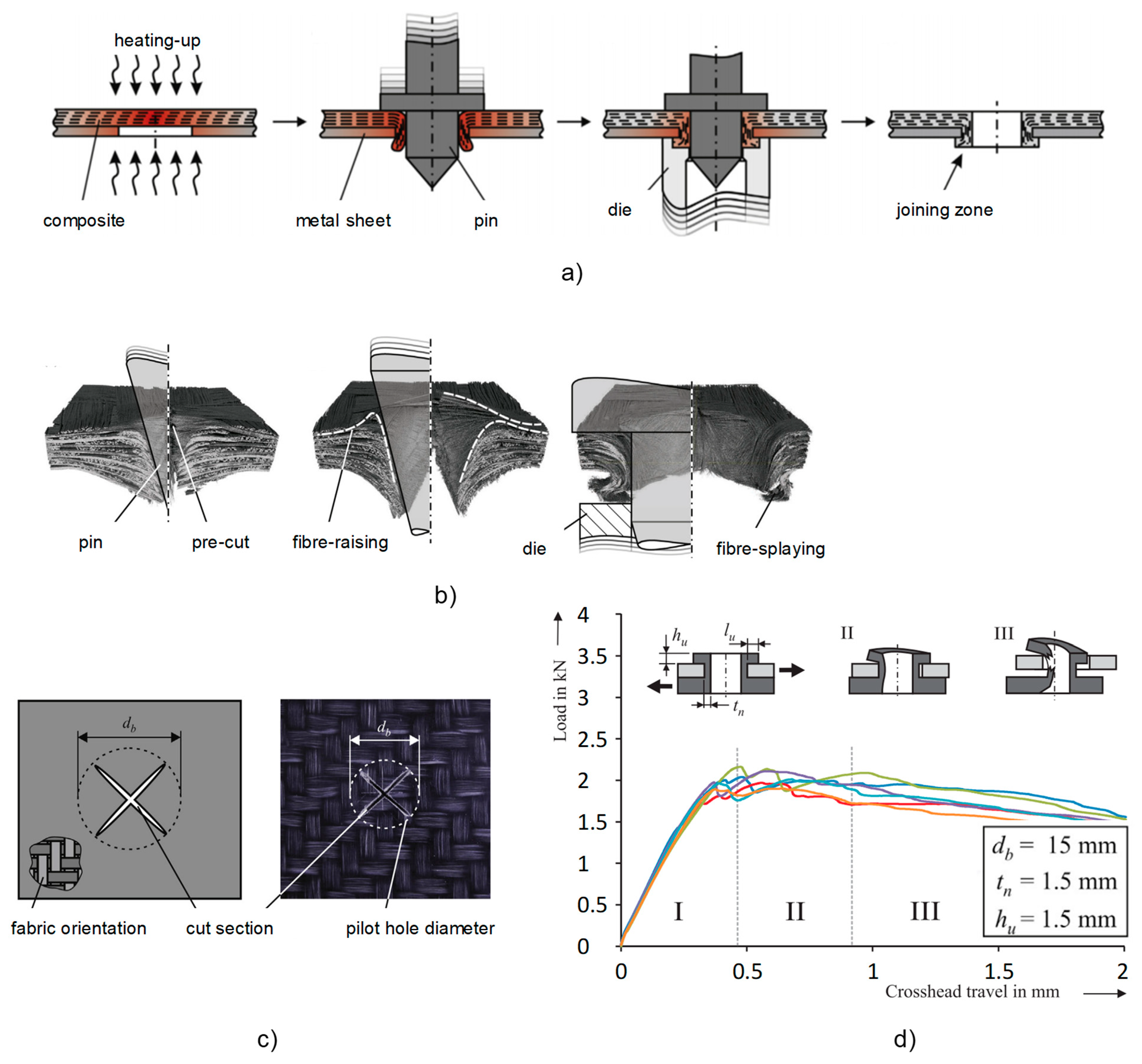
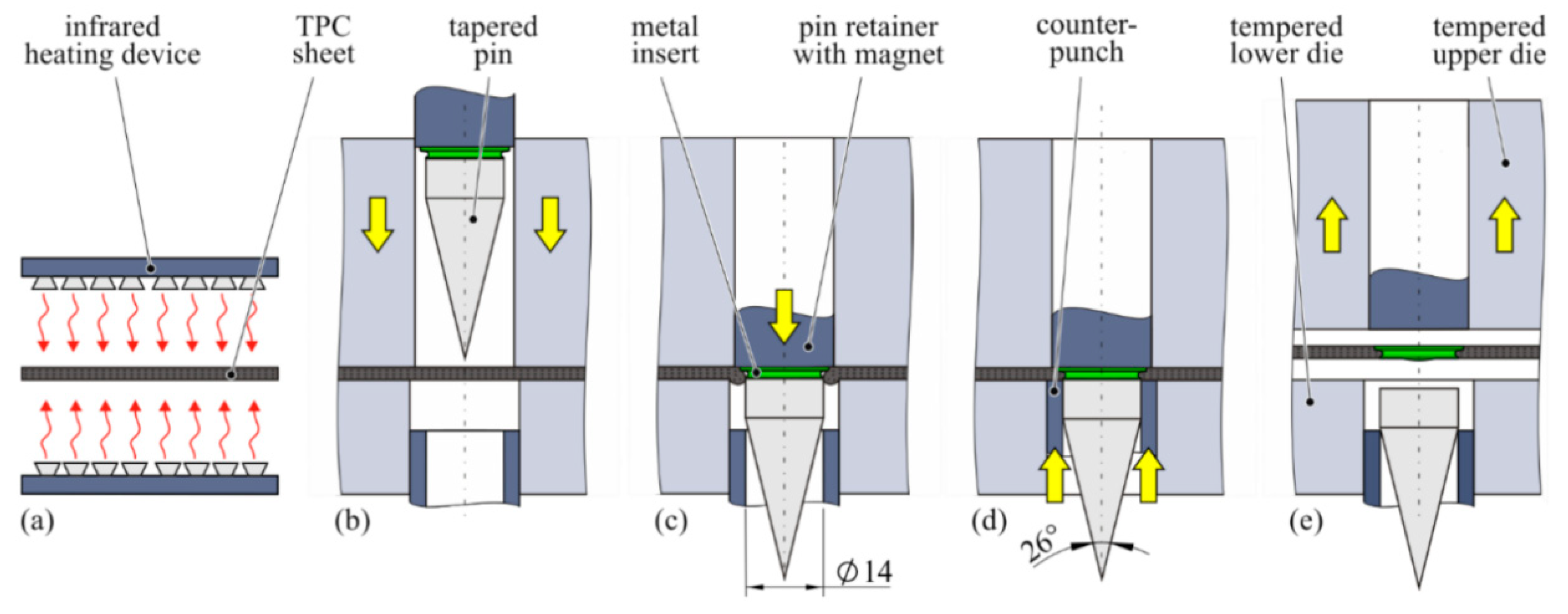
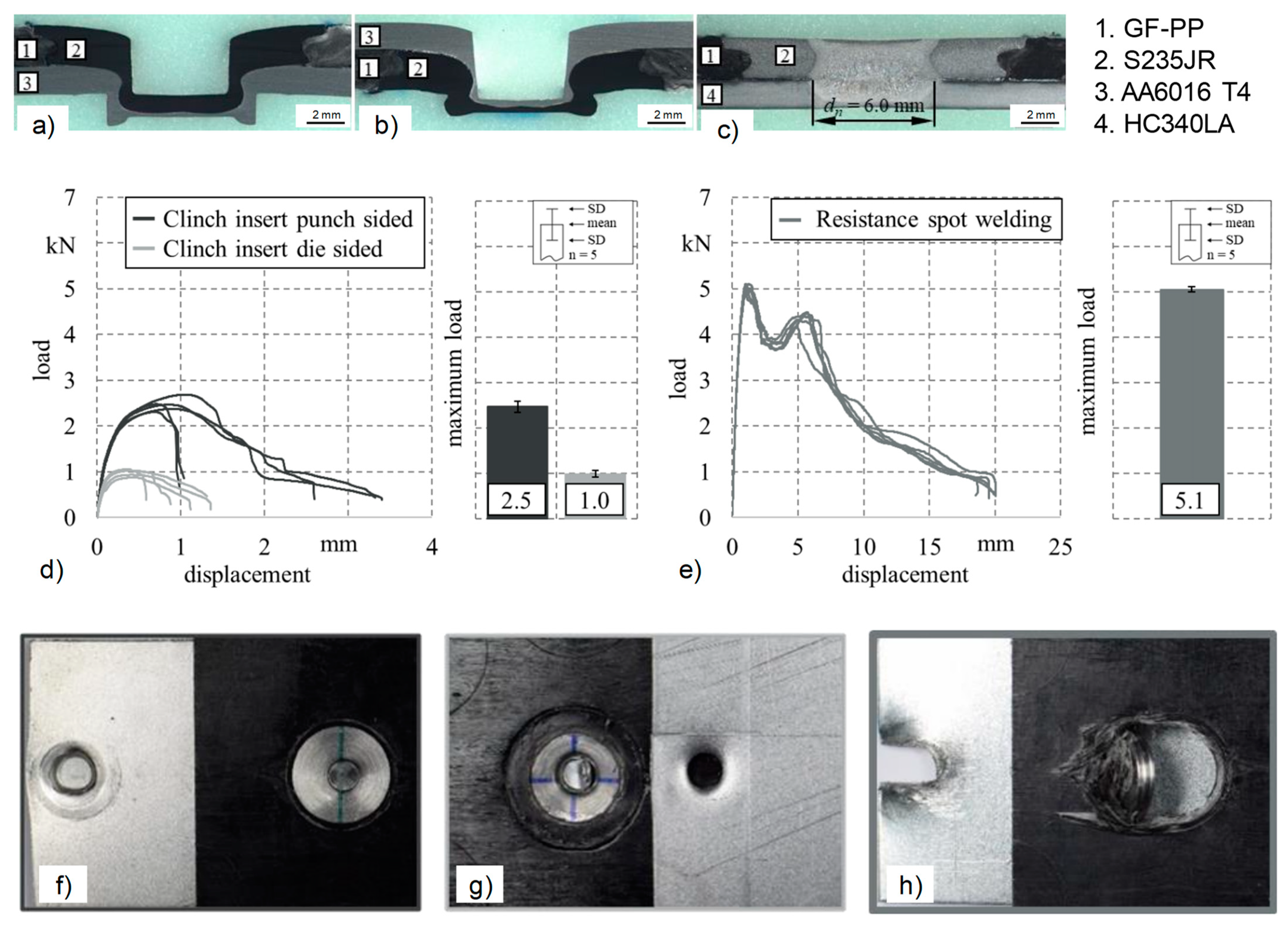
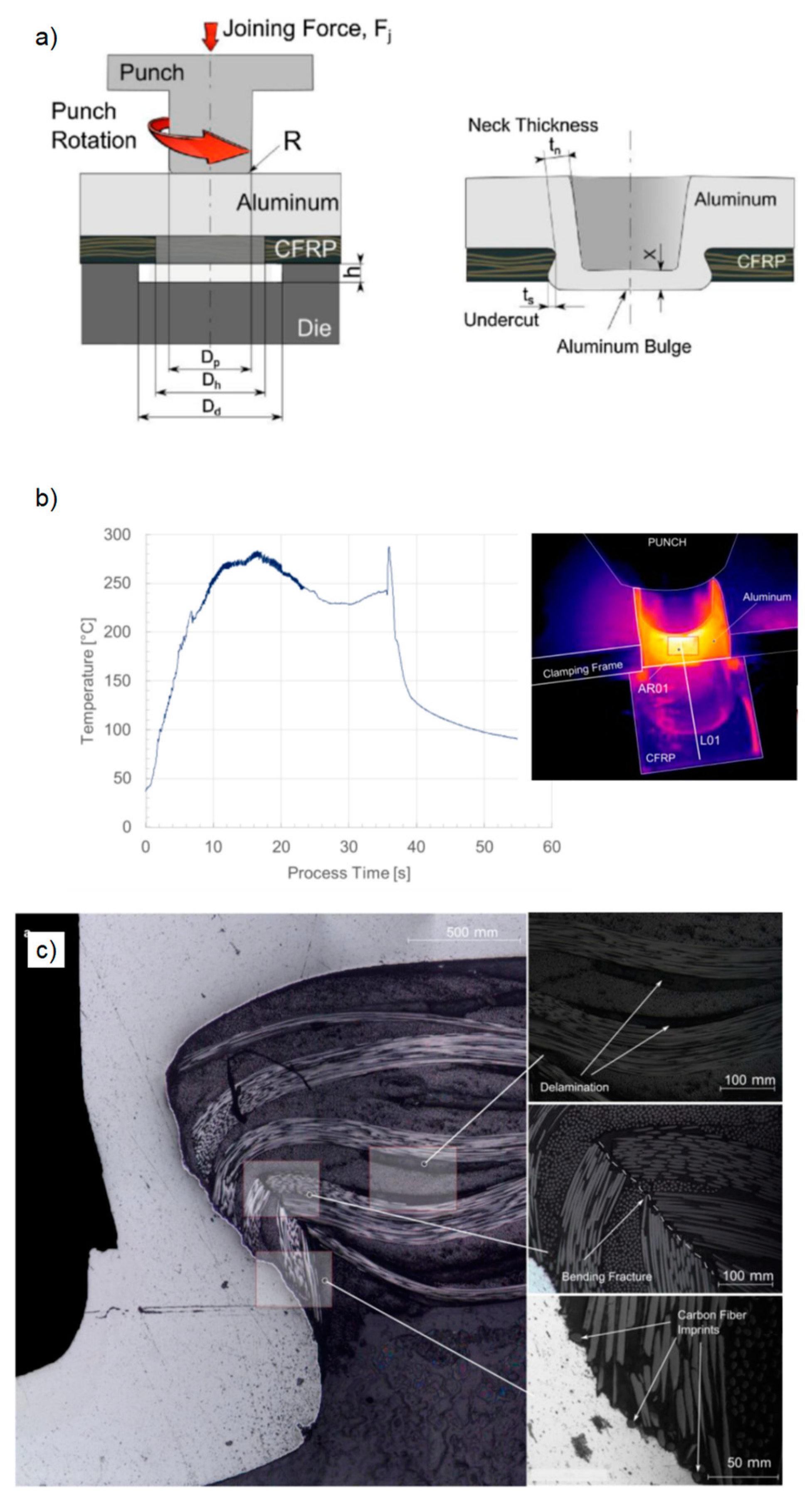
| Clinching Method | Joined Materials | Advantages | Disadvantages |
|---|---|---|---|
| Clinching with pre-hole [61,63,64,68,69] | AA6061 (2.4 mm)/ CFRP (1.6 mm) [61] SPRC440 (1.2 mm) /CFRP (1.2 mm) [63] AA5754 (1.5 mm)/ CFRP (1.0 mm) [64] AA5083 (1.4 mm)/ CFRP (1.0 mm) [68] AA6061-T4 (2.0 mm)/ CFRP (1.6 mm) [69] |
|
|
| Clinching with pre-forming [70,93] | AA5754 H111 (1.5 mm)/ CFRP (0.65 mm) [70] AA5754 H111 (2.0 mm)/ CFRP (0.65 mm) [93] |
|
|
| Clinching with heating [71,72,74] | DC05 (1.5 mm)/ GF-PA6 (2.0 mm) [72,74] AA5052 H32 (1.6 mm)/ CFRTP (1.6 mm) [71] |
|
|
| Thermomechanical mold joining [80,94] | DC04 (1.5 mm)/ GF-PP (1.0 mm) [80] DC04 (1.5 mm)/ CFRP (2.0 mm) [81] DC04 (1.5 mm)/ GFRP (1.0 mm, 1.5 mm, 2.0 mm, 2.7 mm, 3.2 mm, 3.7 mm) [81] |
|
|
| Thermoclinching [82,83,84,85] | DC04 (1.0 mm)/ GF-PP (4.0 mm) [82,83,84,85] |
|
|
| Clinching after embedding of inserts [87,88] | 1.2210 (4.3 mm)/ GF-PP (4.3 mm) [45] AA6016-T4 (1.5 mm)/ GF-PP (2.15 mm) [87] HC340LA (1.5 mm)/ GF-PP (2.15 mm) [87] |
|
|
| Friction-assisted clinching [89,92] | AA6061 (2.0 mm)/ CFRP (1.4 mm) [89] AA6061 (2.0 mm)/ CFRP (2.0 mm) [92] |
|
|
Disclaimer/Publisher’s Note: The statements, opinions and data contained in all publications are solely those of the individual author(s) and contributor(s) and not of MDPI and/or the editor(s). MDPI and/or the editor(s) disclaim responsibility for any injury to people or property resulting from any ideas, methods, instructions or products referred to in the content. |
© 2024 by the authors. Licensee MDPI, Basel, Switzerland. This article is an open access article distributed under the terms and conditions of the Creative Commons Attribution (CC BY) license (https://creativecommons.org/licenses/by/4.0/).
Share and Cite
Han, D.; Hu, C. Clinching of Carbon Fiber-Reinforced Composite and Aluminum Alloy. Metals 2024, 14, 681. https://doi.org/10.3390/met14060681
Han D, Hu C. Clinching of Carbon Fiber-Reinforced Composite and Aluminum Alloy. Metals. 2024; 14(6):681. https://doi.org/10.3390/met14060681
Chicago/Turabian StyleHan, Daxin, and Chengliang Hu. 2024. "Clinching of Carbon Fiber-Reinforced Composite and Aluminum Alloy" Metals 14, no. 6: 681. https://doi.org/10.3390/met14060681






